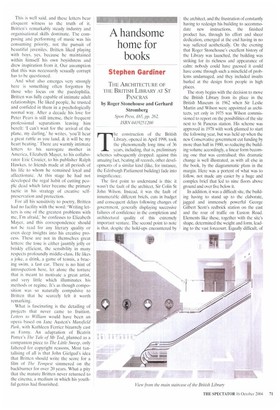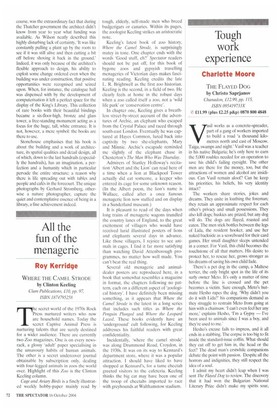A handsome home for books
Stephen Gardiner
THE ARCHITECTURE OF TILE BRITISH LIBRARY AT Si PANCRAS by Roger Stonehouse and Gerhard Stromberg Span Press, £65, pp. 262, ISBN 0419251200 The construction of the British Library, opened in April 1998, took the phenomenally long time of 36 years, including, that is, preliminary schemes subsequently dropped: against this amazing fact, beating all records, other developments of a similar kind (like, for instance, the Edinburgh Parliament building) fade into insignificance.
The first point to understand is this: it wasn't the fault of the architect, Sir Colin St John Wilson. Instead, it was the fault of innumerable different briefs, cuts in budget and consequent delays following changes of government, generally displaying successive failures of confidence in the completion and architectural quality of this extremely important venture. The second point to note is that, despite the hold-ups encountered by the architect, and the frustration of constantly having to redesign his building to accommodate new instructions, the finished product has, through his effort and sheer dedication, emerged at the end having in no way suffered aesthetically. On the evening that Roger Stonehouse's excellent history of the Library was launched, the building was striking for its richness and appearance of calm: nobody could have guessed it could have come through such a minefield of problems undamaged, and they included insults hurled at the design from people in high places.
The story begins with the decision to move the British Library from its place in the British Museum in 1962 when Sir Leslie Martin and Wilson were appointed as architects, yet only in 1975 was Wilson commissioned to report on the possibilities of the site next to St Pancras station, His scheme was approved in 1978 with work planned to start the following year, but was held up when the new Conservative government cut funding by more than half in 1980, so reducing the building volume accordingly, a linear form becoming one that was centralised; this dramatic change is well illustrated, as with all else in the book, by the diagrammatic plans in the margin. Here was a portent of what was to follow, not made any easier by a huge and complex brief that led to nine floors above ground and over five below it.
In addition, it was a difficult site, the building having to stand up to the elaborate, jagged and immensely powerful George Gilbert Scott's redbrick station on the east and the roar of traffic on Euston Road. Elements like these, together with the site's shape, determined the weight and form, leading to the vast forecourt. Equally difficult, of course, was the extraordinary fact that during the Thatcher government the architect didn't know from year to year what funding was available. As Wilson neatly described this highly disturbing lack of certainty, it was like constantly pulling a plant up by the roots to see if it was still alive and then cutting a bit off before shoving it back in the ground.' Indeed, it was only because of the architect's flexible approach to design, his ability to exploit some change ordered even when the building was under construction, that positive opportunities were recognised and seized upon. When, for instance, the catalogue hall was dispensed with by the development of computerisation it left a perfect space for the display of the King's Library. This collection of rare books with their beautiful bindings became a six-floor-high, bronze and glass tower, a free-standing monument acting as a focus for the huge, tall, white entrance. It is not, however, a mere symbol: the books are there to use.
Stonehouse emphasises that his book is about the building and a work of architecture, its spatial qualities and detail design, all of which, down to the last handrails (especially the handrails), has an imagination, a perfection and a humanity which in particular pervade the entire structure; a reason why there is life spreading out with tables and people and cafés in the forecourt. The unique photographs by Gerhard Stromberg, otherwise a nature photographer, capture the quiet and contemplative essence of being in a library, a fine achievement indeed.











































































































 Previous page
Previous page